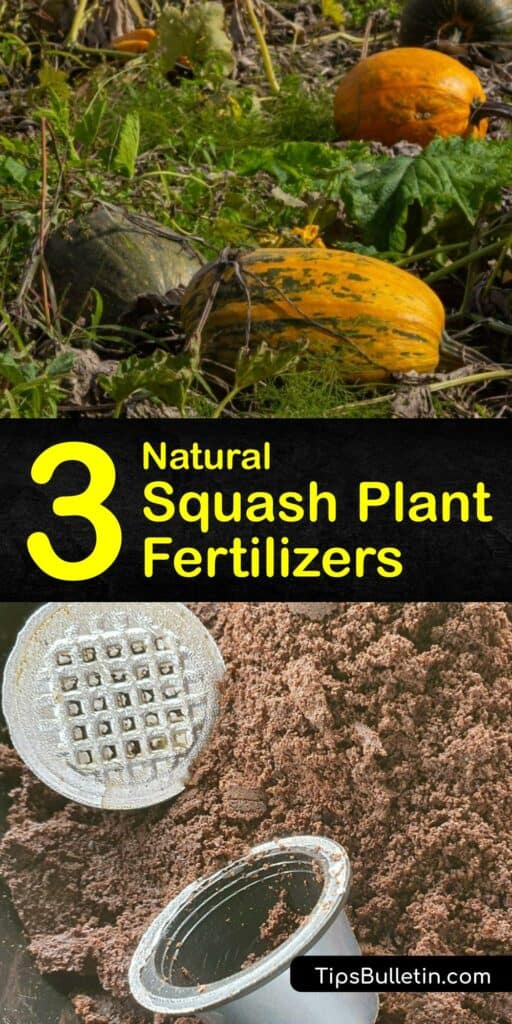Are you looking for ways to feed your squash plants at home without commercial plant food? Unfortunately, fertilizers are expensive these days, and sometimes your local garden center doesn’t have the type you need. Luckily, preparing a homemade fertilizer for squash is easier than you think.
A trip down the fertilizer aisle is daunting since there are different types. Knowing the best fertilizer for your vegetable garden is hard. Do you need a liquid fertilizer or granular fertilizer, or should you buy manure?
Squash plants require proper nutrients throughout the growing season, whether butternut squash or zucchini plants. A natural fertilizer takes all the guesswork out of gardening. It provides your plants with a balance of nutrition and lessens the chance of over-fertilizing.

Homemade Fertilizers for Squash Plants
Making your own fertilizer may seem intimidating, but it’s not as difficult as you think. In fact, many items around your home are perfect for feeding a squash plant, and some of them may surprise you.
Not only is an organic fertilizer healthier for your plants, but it’s also better for the environment than chemical fertilizers. It encourages strong plant growth, acts as a soil amendment, and is ideal for pest and weed control. Learn how to fertilize your plants with organic and homemade fertilizers, like compost, Epsom salt, and kitchen scraps.

Organic Squash Plant Fertilizer and Plant Care Tips
Synthetic fertilizers contain several chemical combinations, and these chemicals cause havoc to the soil over time. Luckily, the earth provides us with everything we require to garden, including plant food for cucumbers and squash. Find out how to fertilize squash by composting organic matter.
You can make different fertilizers for squash and pumpkins with yard trimmings and leftover kitchen scraps using compost. All you need is a bin or area of the yard for a compost pile. Add organic matter and water a little at a time, turn the heap, and you’re rewarded with black gold fertilizer.
Mix even layers of three parts brown and one part green materials. Brown materials are dried leaves, shredded paper, straw, and sawdust. Greens are grass clippings, fruit and veggie scraps, and coffee grounds.
Water the pile regularly to keep it moist and not soggy, and turn it over every three days. You eventually end up with finished compost to add to the garden soil, spread around squash plants, or make compost tea for plant watering.
Dr Earth fertilizer and Miracle Gro Performance Organics are terrific substitutes if you don’t have the time or space for composting. Simply follow the directions and apply the fertilizers just before the runners start spreading. Spread the plant food six to eight inches away from the plant on each side.
Depending on your soil type, squash plants want about an inch of water weekly. Summer squash is generally ready to harvest 60 days after planting when they are six to eight inches long.
Winter squash is ready for picking when the rind is hard and resists puncture from a fingernail. Avoid pulling the fruit from the vine. Instead, use a sharp knife or shears to cut them from the stem, leaving part of the vine attached.
Store summer squash varieties in a crisper drawer or storage bag in the refrigerator for up to seven days. Winter squash lasts up to six months in a cool, dark place.
How to Fertilize Squash With Epsom Salt
As strange as it sounds, you can make your own zucchini fertilizer with Epsom salt; it’s an excellent organic squash plant fertilizer. It helps squash seeds germinate, supports nutrient absorption, boosts fruit development, and deters pests. Discover how this miracle salt can feed your summer or winter squash.
Epsom salt is the best fertilizer for squash plants to keep the cucumber beetle and other pests away from your plants. It’s a natural way to deter harmful bugs without harming pollinators necessary for the male flower and female flower on the squash plant. It also treats powdery mildew.
It is a good magnesium source, allowing the plant to absorb more nutrients. In addition, it helps with photosynthesis and improves the plant’s ability to produce flowers and fruit.
To prepare a liquid fertilizer with this salt, pour a gallon of water into a watering can and add two tablespoons of Epsom salt. Stir the liquid, and water the Epsom squash plant food around the plant’s base once or twice a month.
Homemade Fertilizer for Squash
Instead of tossing those banana peels, eggshells, and coffee grounds into the trash, use them for fertilizing squash. These leftover kitchen scraps are ideal for feeding winter and summer squash like zucchini and giant pumpkins. Learn how to fertilize squash with homemade plant food made from leftovers.
Banana peels, eggshells, and coffee grounds are excellent for recycling into an organic squash plant fertilizer. The coffee provides them with nitrogen, the banana peels add potassium and phosphorus to the soil, and eggshells are a good source of calcium. Whole eggshells are also great for starting a squash seed indoors.
Place crushed eggshells, sliced banana peels, and leftover coffee grounds into a large pot to make a DIY fertilizer for squash. Submerge them with water, cover the pan, and let them steep overnight.
In the morning, strain the solution into a watering can and water your plants. If you prefer to make a foliar spray, pour the liquid into a sprayer and spray the squash vines and leaves with the liquid fertilizer.
While an inorganic fertilizer is convenient and easy to use, organic fertilizers are natural and provide plants with the nutrients needed to thrive. In addition, they don’t harm the environment, and you have all the ingredients to make the best fertilizer for your squash plant garden.

We hope you enjoyed learning how to prepare a homemade fertilizer for squash, and we’d love it if you’d share our DIY squash fertilizers with your friend and family circle on Pinterest and Facebook.